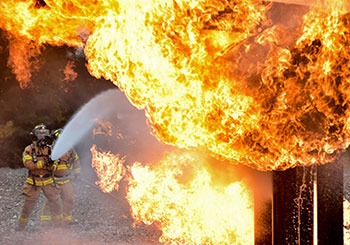Burn and Explosion Injuries Lawyers
What is a Burn Injury Case?
 Our award-winning Wyoming burn injury attorneys can help you or a loved one seek the damages you deserve following a serious and painful fire or accident.
Our award-winning Wyoming burn injury attorneys can help you or a loved one seek the damages you deserve following a serious and painful fire or accident.
Burn injuries are among the most painful and emotionally damaging injuries a person can suffer. Serious burn injuries often result in multiple surgeries, skin grafts, and reconstructive plastic surgery. Wounds are left vulnerable to fatal infections for years following an incident. Burn injuries have extreme, life-long impacts that include extensive hospital stays, scarring, and disfigurement, as well as higher risks of developing skin cancer, among many other complications.
Severe burns caused by prolonged exposure to intense heat, chemicals, or explosions damage much more than the outer layer of a person’s skin. Fourth-degree burns destroy the epidermis and dermis, as well as muscle tissue, nerves, tendons, bones, and glands below the skin resulting in extensive and life-threatening injury.
Industrial plants, oil fields, construction sites, and restaurants are common locations for workplace fires and explosions due to the nature of the equipment and materials being used. While accidents do happen, the majority of these incidents are preventable and are often caused by negligence on the part of an individual or organization:
- Defective and malfunctioning machinery
- Unsafe workplace conditions
- Failure to store chemicals properly
- OSHA violations
- Failure to train staff properly in the handling of flammable materials
- Smoking
- Defective kitchen equipment
Types of Burn Injuries
While exposure to open flame and explosions are common causes of serious thermal burn injuries, there are several other types of burns that can cause catastrophic pain and injury:
- Friction Burns are caused when a hard surface is scraped quickly along the skin, causing both an abrasion and a heat-inflicted wound. This type of injury is commonly seen in motorcycle, vehicle, or bicycle accidents.
- Cold Burns, also known as “frostbite”, can occur when skin is exposed to freezing temperatures (below 23℉) for extended periods of time. Cold burns can lead to severe nerve damage and amputation.
- Chemical Burns occur when the skin comes in contact with strong acids, solvents, or harsh substances such as paint thinner, gasoline, and bleach that can cause tissue damage.
- Electrical Burns can damage the body both internally and externally depending on the strength of the electrical current. Serious electrical burns can happen in an industrial setting, at construction sites, and due to downed power lines among other possible causes, and can affect the functioning of major organs.
- Radiation Burns can be as simple as a sunburn or more complex involving x-ray treatments or a malfunction of equipment including tanning beds. They are caused by prolonged exposure to UV rays and are known to cause cancer, cataracts, and other medical conditions.
If you have suffered a serious burn, the most important thing you can do is seek medical attention immediately. The faster a burn wound is treated, the less damage it will ultimately cause. To learn more about specific types of burns visit the Burn and Reconstructive Centers of America website.
How Serious is My Burn?
Doctors classify burns based on the severity and depth of the injury by “degrees” that range from first to fourth degree. The higher the degree of a burn, the more damage has been done to tissue, nerves, bone, and organs.
- First-degree burns are generally superficial and only affect the epidermis or the outermost layer of the skin. The skin may be red and painful, but will not produce blisters, and will heal without lasting damage.
- Second-degree burns damage the epidermis and the underlying skin, the dermis. The skin will be red, shiny, and painful to the touch, with visible blisters. Some minor scarring may occur.
- Third-degree burns are also known as “full-thickness burns” as they completely damage both layers of skin which may turn brown, black, yellow, or white. A third-degree burn will not be painful because it damages the nerves at the point of contact.
- Fourth-degree burns are the most severe, and potentially life-threatening, damaging skin, nerves, bone, and other tissue.
What Determines Damages in a Burn Injury Case?
Depending on the severity of your injuries, and the extent of the treatment needed, there is a range of damages you can seek to cover the physical and emotional injury you have endured and expect to endure in the future. Both economic and non-economic damages are possible to recover, providing there is proper documentation and evidence.
There are some key factors to consider as you move forward with your claim:
- What percentage of your body was burned?
- What was the extent of your pain and suffering?
- How much permanent scarring will remain publicly visible?
- Were there serious complications, such as infections, that slowed healing?
- If there are permanent physical limitations, how will they impact the enjoyment of your life and ability to make a living?
- What is the psychological impact of your injury?
- What are your expected future medical needs?
When to Contact An Attorney
Like many personal injury cases, burn injuries easily become complex as the injured party's lawyers will need to conduct an investigation, gather evidence, and demonstrate cause in order to successfully pursue a lawsuit. It is important to connect with an attorney immediately to help you assess the unique circumstances of your situation and implement the next steps toward regaining your life.
Our award-winning Wyoming burn injury attorneys at the Fitzgerald Law Firm have experience building and trying successful cases arising from explosions and burns in homes, refineries, oil wells, pumping stations, overhead power lines, truck and automobile crashes, and many other types of accidents.
Contact our firm today to discuss the extent of your case, and receive the legal support you need to heal and recover.